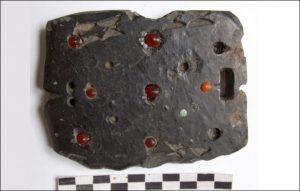Archaeologists discovered remains of a buried nomadic Xiongnu woman wearing decorated belt buckles made of coal at the Ala-Tei burial ground on the Yenisei River in the Republic of Tuva, South Russian Federation.

The archaeological expedition to the remote site, led by Marina Kilunovskaya, uncovered since 2015 around 80 burials of the Xiongnu. Most of the individuals were buried in rectangular stone boxes, sometimes boat-shaped, or in wooden coffins or frames, with a stone covering. Some burials are said to be without any construction inside and many contain the heads of horses. The area is relatively rich in various burial grounds dated from Scythian times to the Middle Ages (2nd century BC to the 12-13th centuries AD). Some of them are said to be under threat of destruction by water.

Archaeologist identify the findings as belonging to the Xiongnu, which were a confederation of nomadic peoples who, say ancient Chinese sources, inhabited the eastern Asian Steppe from the 3rd century BC to the late 1st century AD. According to the researchers the belt is the main attribute of the nomads, so it was richly decorated with various plaques – mostly of bronze, but also coal. Women buried at the necropolis went to the afterlife wearing decorated belt buckles made of coal and adorned with flame-shaped bronze decorations on their shoulders. They also wore bronze buckles on their belts, while Xiongnu men wore buckles mainly of iron. These buckles were decorated with depictions of animals such as dragons, leopards, panthers, horses, yaks and snakes. According to Marina Kilunovskaya there are only ten such coal buckle decorations in the world and there are four known from the site.


(after Marina Kilunovskaya, Russian Federal Center for Integrated Arctic Research & The Siberian Times)